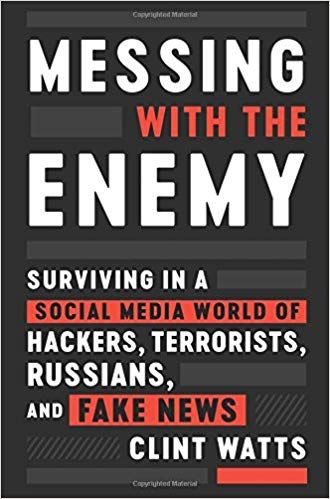Book of the Year: "Messing With the Enemy"
Clinton Watts' book from mid-2018 was the most informative volume of the year

In a year replete with social media scandals, elections meddling, flooding bots, and digital espionage, it seems fitting to select as my Book of the Year a superb read by a former counterintelligence specialist with the FBI:
“Messing with the Enemy: Surviving in a Social Media World of Hackers, Terrorists, Russians, and Fake News,” by Clint Watts.

“Messing with the Enemy” is a sobering account of the nearly 20 years of information warfare that Russia, al-Qaeda, ISIS, and others have waged on Western alliances and their members. Watts, whose testimony last year before the Senate Intelligence Committee was a wake-up call to anyone watching, carefully describes the through-line from a simple HTML world where connectivity liberated information from its local stores to the intrusive, abusive, and divisive information landscape of today.
A filter bubble — a term coined by Eli Pariser in his 2011 book of the same name — is a familiar concept, but Watts believes that over the ensuing years something more fundamental has taken hold which has changed how we perceive ourselves, one another, and our relationship with the physical world and empirical reality, writing:
The Internet brought the world together, but, over time, social media has torn the world apart. There are many reasons why this has happened, but one factor stands above the rest: preference. . . . The relentless pursuit of preferences turns smart crowds into dumb mobs, leads to the selection of preferred fictions over actual facts, and creates an environment where humans have access to more information than ever but actually understand less about the physical world. . . . Online, the pursuit of comfort and confirmation create an alternative reality.
At the base of the changes wrought by social media — a euphemism at this point, surely, for coercive media — were at least three important factors:
- Coercive media was available to anyone — targets and agents — at no cost. It made no distinction between the core and the crowd.
- There was an initial assumption that the core — educated, experienced professionals — would remain highly influential within social media, which led to the lax development of guardrails. The engineers thought the guardrails would install themselves. But now, the crowd competes quite effectively with the core, even dominating it in many instances.
- The traditional and well-known core is being replaced by a new and unaccountable core — shadowy, corrupt, and power-hungry — that is using social media to seed dissent, confusion, and divisions in Europe, the US, the Phillipines, Myanmar, and elsewhere.
The first element clearly enabled the second and third elements, as various disenfranchised groups — disenfranchised in some important cases because society had rightly marginalized them (e.g., racists, terrorists, and criminals) — were provided with free access to platforms where they could target like-minded individuals (i.e., other racists, other terrorists, and other criminals), masquerade as legitimate entities, and slip by societal screens put in place to marginalize them, thereby gaining new handholds in society. Not only that, but these platforms were instantly global, allowing racists, terrorists, and criminals to appeal to others and coordinate activities across continents, countries, and time zones.
The business model has evolved into one of surveillance and data dominance, Watts writes.
Watts also points to the lack of barriers to entry, barriers that paid services erect natively — some call them paywalls, some paypoints, some subscriptions, but the lesson is that if something requires someone to pay to use it, there is a modest but important barrier. That’s not always a bad thing, even if some of us reflexively view such barriers as “undemocratic” or “elitist.” Democracies are usually democratic republics, and assume an accountable elite core will correct what the crowd gets wrong, something worth remembering as a lesson our forebears learned. Watts writes:
No barriers to entry and unlimited preference in the virtual world have overtaken compromise in the real world.
Lowering or eliminating barriers to entry sounds laudable, but in reality it has allowed fringe viewpoints to go to scale on the major platforms.
Watts is an excellent, lucid, and organized writer, and carefully leads the reader through complicated materials with patience and clarity.
“Messing with the Enemy” is eminently readable, vitally important, and will give you a startling view into how long what seems recent has been developing, from the early 1990s to this very day.
Highly Recommend.